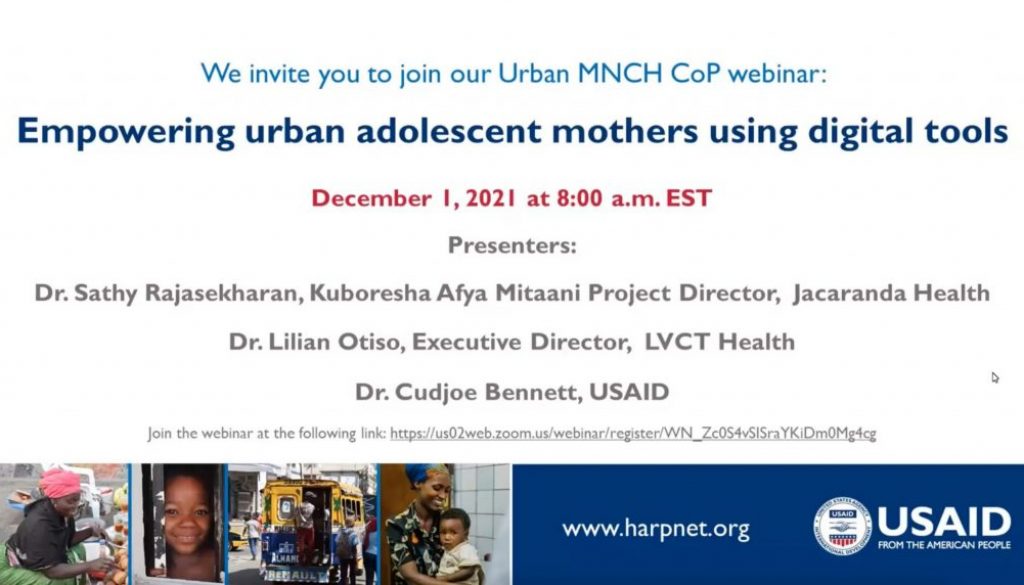Supporting adolescent mothers in Nairobi’s informal settlements
This blog by Lynda Keeru and Kate Hawkins (Pamoja Communications) reports back on the recent webinar – ‘Empowering urban adolescent mothers using digital tools’ – which was organized by the USAID Urban Health Community of Practice. The webinar on urban adolescents showcased implementation research to ensure rapid knowledge and learning from evidence. It featured speakers from theKiboresha Afya Mitaani Project and LVCT Health, both based in Kenya.
The scale of the issue
Teenage pregnancies continue to be a pervasive phenomenon in Kenya – over 50% of all maternal deaths from unsafe abortions in Nairobi are young women aged between 15 and 24 years of age. Forty-one percent of adolescent pregnancies in Kenya’s informal settlements are unintended – either mistimed or unwanted.
Dr. Lilian Otiso, Director of LVCT reiterated that teenage pregnancies are a key concern, so much so that during the recently celebrated World AIDS Day, part of Kenya’s priority areas and focus were the link between teenage pregnancies and HIV. This came from the recognition that the highest number of new HIV infections are among the population. The President of Kenya restated the need to find strategies to solve these issues together because they undermine socio-economic growth and negate the progress made to end AIDS.
Addressing mother’s needs and challenges
‘Kuboresha Afya Mitaani’, a USAID-supported implementation research project, came to life with an aim of contributing to better maternal, newborn and child health (MNCH) outcomes for 60,000 of Nairobi’s most vulnerable women and children. They focus on improving understanding of the drivers of poor health and testing innovative solutions that catalyze political interest and produce replicable models for other urban contexts.
This involves getting a better understanding of the unique and contextual needs of the individuals and communities in order to develop context-specific human-centered solutions that put at the core the voices of mothers and their support systems. The process also includes generating evidence to catalyze government interest in the adoption, implementation and scale up of the interventions. They use implementation research to establish a participatory forum of multiple stakeholders to own these interventions and ensure future sustainability.
The co-created, demand-driven data collected by the project revealed three areas of need for adolescent mothers:
- Informational: Lack of information hinders care seeking, lack of knowledge about pregnancy itself
- Emotional: Stressors on young mothers, isolation, stigma, violence and abuse and financial challenges
- Care based: Disrespect in health care settings, lack of knowledge of entitlements, poor facility settings
Dr. Sathy Rajasekharan, Co-Executive Director, Jacaranda Health, explained how the project is using digital mechanisms, such as a free text messaging service to provide pregnancy information and field questions about pregnancy, birth and the post-partum period. They receive up to 3500 messages a day from across the country and includes a million mothers. It ensures that women with clinical questions are referred to health facilities.
The picture in informal settlements
Dr. Otiso explained how adolescent pregnancies are worse in informal urban settlements than in the rest of the country. The ARISE consortium focuses on accountability within informal urban settlements and the factors that affect the health and wellbeing of people in these spaces. Policy makers often have low levels of data from these settings and so the community’s needs are often invisible in policy and programming. Lilian explained that informal settlement dwellers are commonly left out of financing options and in programs like the rollout of UHC.
Solutions need to combine different elements of programming – community based interventions and digital technologies – to address the challenges of adolescent pregnancies and the need to care for girls in informal settlement settings and other hard to reach places. Communities must be empowered to use accountability mechanism to get redress from facilities or the state. These systems need to acknowledge that some groups within informal settlements – such as young people – are more marginalized than others.
She argued that it is sensible to combine some social accountability mechanisms like community scorecards, participatory action research cycles, and work improvement teams at community level with data that is being generated through the digital platforms to feedback to the community as well as health workers and planners.
Future directions
It is crucial to form partnerships to implement these projects and to scale up. There is a host of diverse research on informal settlements that can be brought to bear in our mutual challenge to produce and share knowledge that is critical for policy and for scale up. It is also important to strengthen policy at national and county level to support adolescent mothers and their newborns and children. The webinar also highlighted that embedded implementation research is demonstrating its ability to uncover critical information to affect change in hard-to-reach populations (i.e. adolescent girls living in informal settlements). The findings have numerous potential implications for other urban areas in Kenya and across the region.
Moderator:
Dr Cudjoe Bennett, USAID
Contributors:
Dr Sathy Rajasekharan, Kiboresha Afya Mitaani Project Director, Jacaranda Health
Dr Lilian Otiso, Executive Director, LVCT Health

